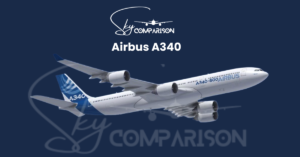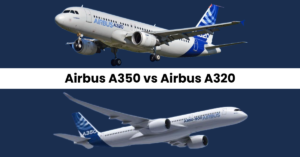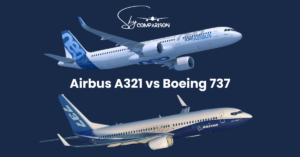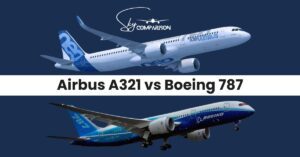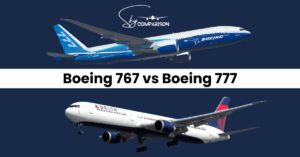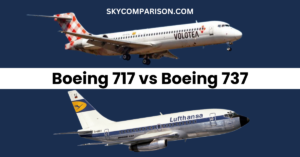Airbus A380 vs Boeing 747: Superjumbo vs Queen of Skies
The aviation industry has been dominated by two iconic aircraft for decades: the Airbus A380 vs Boeing 747. These giants of the sky have revolutionized air travel, offering unparalleled capacity, range, and technological advancements. In this article, we will dive deep into a comparison between these two marvels of aviation engineering, exploring their differences and similarities.
Airbus A380 vs Boeing 747
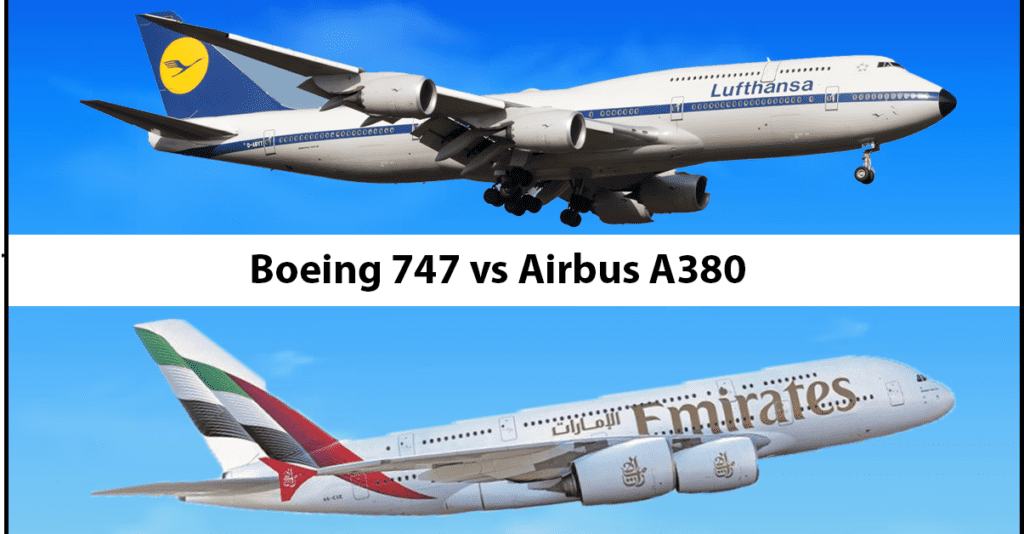
The Airbus A380 vs Boeing 747 showdown encapsulates a thrilling chapter in aviation history. The A380, Airbus’s luxury “superjumbo,” challenged Boeing’s iconic 747, the long-reigning “Queen of the Skies.” While the A380 impressed with its size and comfort, the 747’s adaptability kept it a staple in both passenger and cargo sectors. This rivalry goes beyond specifications, highlighting the dynamic nature of air travel and the varying fortunes of these two remarkable aircraft in an ever-evolving industry.
This table succinctly compares the key features of the Airbus A380 and Boeing 747, highlighting their unique characteristics and contributions to the aviation industry.
| Feature | Airbus A380 | Boeing 747 |
|---|---|---|
| First Flight | 27 April 2005 | February 9, 1969 |
| Passenger Capacity | 525, Maximum 853 | 416, Maximum 660 |
| Range | 15,200 km | 13,450 km |
| Length | 73 m | 76 m |
| Weight | 560 tons | 975,000 lb (442 t) |
| Cruising Speed | 903 km/h | 914 km/h |
| Top Speed | 1,185 km/h | 988 km/h |
| Wingspan | 80 m | 68 m |
| Engine | Rolls-Royce Trent 900, Engine Alliance GP7000 | General Electric GEnx |
| Fuel Capacity | 250 metric tons (320,000 liters) | 238,604 liters |
| Prices | 25.18m$ to $76.93 million | $418.4 million |
The Airbus A380
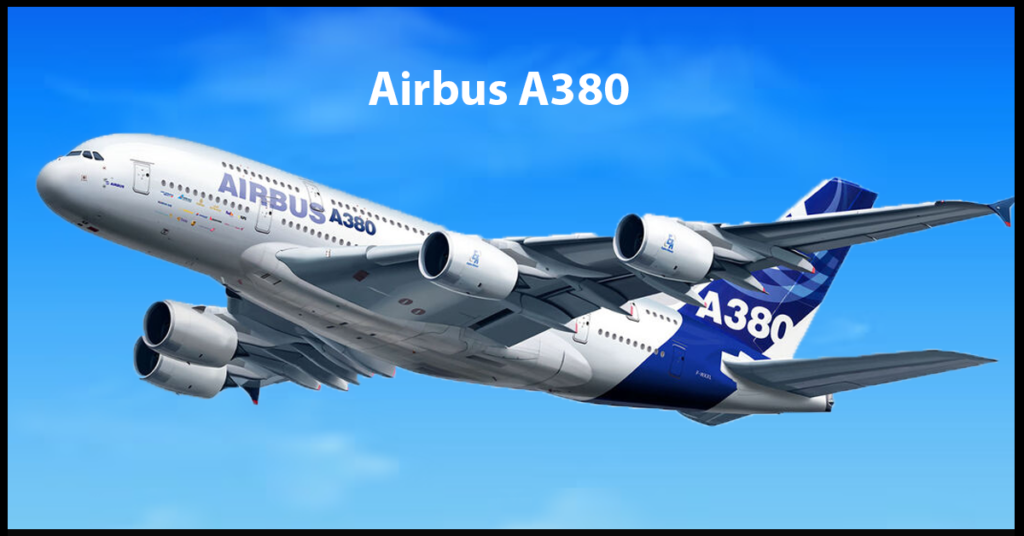
The Airbus A380, often referred to as the “superjumbo,” is the world’s largest passenger airliner. Developed by the European consortium Airbus, it made its first flight in 27 April 2005. This double-decker aircraft was designed to challenge Boeing’s monopoly in the large-aircraft market, boasting an impressive capacity that can comfortably carry more than 500 passengers. With its advanced technology and emphasis on passenger comfort, the A380 has been a popular choice for long-haul flights among many airlines.
The Boeing 747
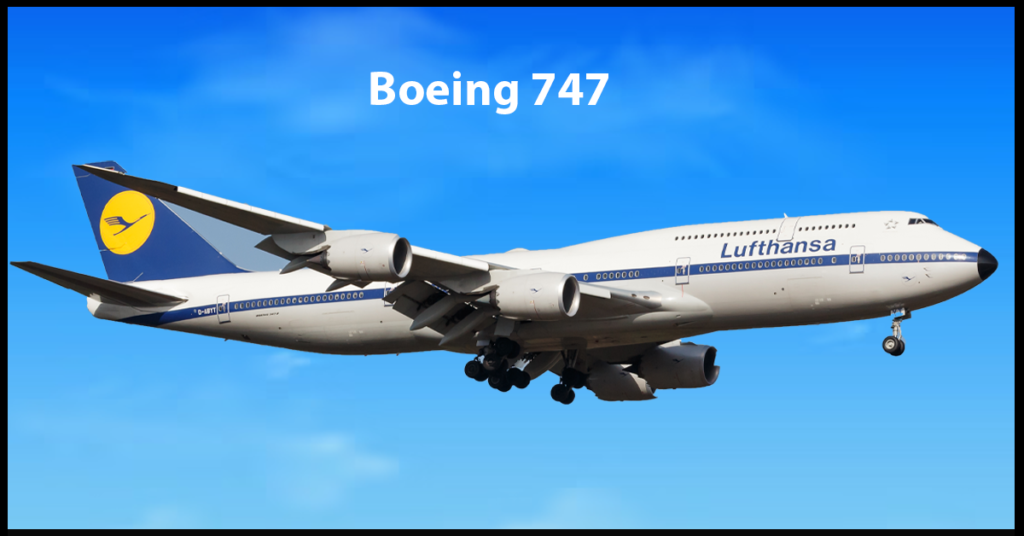
The Boeing 747, famously known as the “Queen of the Skies,” first took to the air in 1969, marking the beginning of a new era in commercial aviation. This aircraft was the first wide-body airliner in the world and held the passenger capacity record for 37 years until the A380 came along. Renowned for its distinctive hump, the 747 has been a symbol of air travel for several generations and has continuously evolved over the decades to meet changing market demands.
A380 vs 747 size comparison
The Airbus A380 and the Boeing 747 are two of the largest passenger planes in the world, but in an A380 vs 747 size comparison, the A380 is noticeably bigger. The A380, often called the “superjumbo,” is the largest commercial aircraft ever built. It can carry up to 853 passengers in an all-economy class configuration and has a wingspan of about 261 feet. In contrast, the Boeing 747, known as the “Queen of the Skies,” can carry up to 660 passengers in a similar configuration and has a wingspan of about 225 feet. The A380 is also longer, measuring 238 feet in length compared to the 747’s 232 feet. This extra size allows the A380 to offer more space and comfort for passengers, making it a favorite for long-haul flights.
| Feature | Airbus A380-800 | Boeing 747-400 | Boeing 747-8 |
|---|---|---|---|
| Length | 238 feet (72.7 meters) | 231 feet 10 inches (70.6 meters) | 250 feet 2 inches (76.3 meters) |
| Wingspan | 261 feet 8 inches (79.8 meters) | 211 feet 5 inches (64.4 meters) | 224 feet 7 inches (68.4 meters) |
| Height | 79 feet (24.1 meters) | 63 feet 8 inches (19.4 meters) | 63 feet 6 inches (19.4 meters) |
| Maximum Takeoff Weight (MTOW) | 1,268,000 pounds (575,000 kg) | 875,000 pounds (396,900 kg) | 987,000 pounds (447,700 kg) |
| Maximum Passenger Capacity | 853 in all-economy configuration | 660 in all-economy configuration | 605 in all-economy configuration |
| Typical 3-Class Capacity | 555 | 416 | 467 |
| Range | 8,000 nautical miles (14,800 km) | 7,285 nautical miles (13,490 km) | 7,730 nautical miles (14,320 km) |
| Engines | 4 x Rolls-Royce Trent 900 or | 4 x Pratt & Whitney PW4000 or | 4 x General Electric GEnx-2B67 |
| Engine Alliance GP7200 | General Electric CF6-80C2 | ||
| First Flight | 27 April 2005 | 9 February 1969 | 8 February 2010 |
| Entry into Service | 25 October 2007 | 22 January 1970 | 25 October 2011 |
This table highlights the differences in size, capacity, range, and other specifications between the Airbus A380 and the two main variants of the Boeing 747.
A380 vs 747 passenger capacity
When comparing the A380 vs 747 passenger capacity, the Airbus A380 has a clear advantage. The A380, known as the “superjumbo,” can hold up to 853 passengers in an all-economy configuration, making it the largest commercial aircraft in the world by passenger capacity. In a typical three-class setup, it comfortably accommodates about 555 passengers. On the other hand, the Boeing 747, often called the “Queen of the Skies,” can carry up to 660 passengers in an all-economy setup. In a standard three-class configuration, it usually seats around 416 passengers. This means that the A380 can transport more people on a single flight, offering airlines the potential to maximize efficiency and reduce costs on busy long-haul routes.
Airbus A380 vs Boeing 747 Interior
When comparing the interiors of the Airbus A380 and Boeing 747, we delve into a realm where luxury, innovation, and passenger experience are paramount. Each aircraft presents a unique approach to interior design, reflecting their respective visions of air travel.
Airbus A380 Interior
The interior of the Airbus A380 is a testament to modern aviation luxury. Its standout feature is the sheer volume of space, thanks to its double-decker design. This space has allowed airlines to customize their cabins with amenities that were once unthinkable in an airliner. Some configurations include shower spas, onboard lounges, and even private suites.
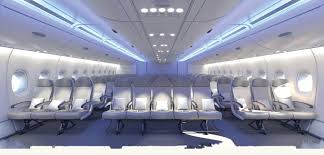
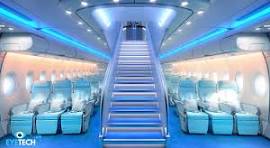
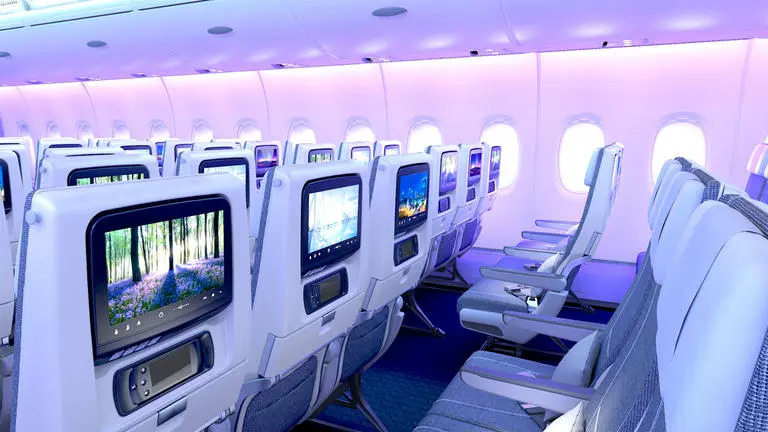
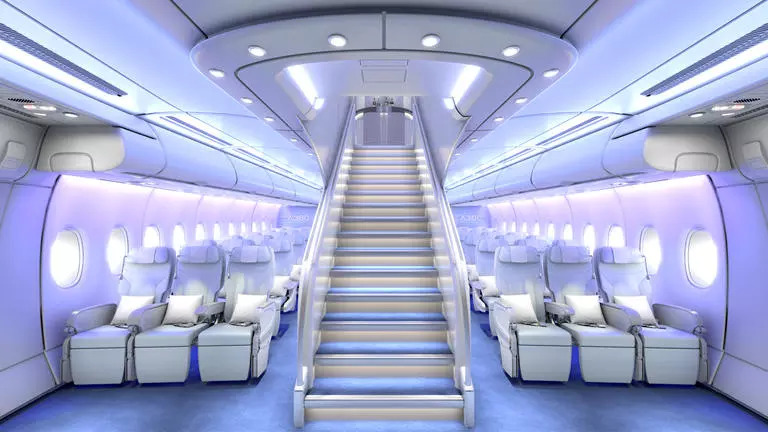
The A380’s cabin is also known for its quietness, an aspect that significantly enhances passenger comfort, especially on long-haul flights. The wider body of the aircraft translates into wider seats and aisles, making for a more comfortable journey, particularly in economy class. The lighting systems in the A380 are designed to reduce jet lag, and larger windows ensure a brighter, more airy environment.
Boeing 747 Interior
The Boeing 747’s interior, while not as spacious as the A380, has its own charm and historical significance. The upper deck of the 747, originally designed as a lounge area in the early models, has evolved into a premium space for business or first-class passengers, offering a more intimate and exclusive experience.
The main cabin, though narrower than the A380, is designed to maximize comfort and efficiency. The 747 has been continually updated with modern amenities, including advanced in-flight entertainment systems, mood lighting, and improved seating across all classes. The iconic hump of the 747 gives the aircraft a unique interior layout, providing passengers with a different spatial experience compared to traditional single-deck aircraft.
Design and Capacity
Airbus A380:
- Double-decker layout.
- Standard seating for 525 passengers, maximum of 853.
- Wider cabin for increased passenger comfort.
Boeing 747:
- Partial double-decker design.
- Typically seats 416 passengers, with a maximum of 660.
- Iconic hump and upper deck.
Performance and Range
Airbus A380:
- Range of 8,000 to 15,000 kilometers, depending on the model.
- Slower cruising speed compared to the 747.
- Requires longer runways for takeoff and landing.
Boeing 747:
- Range varies from 8,000 to over 13,000 kilometers.
- Faster cruising speed.
- More versatile in airport compatibility.
Efficiency and Operation
Airbus A380:
- Advanced aerodynamics for reduced fuel consumption.
- Higher operational costs due to size.
- Preferred for high-capacity, long-haul routes.
Boeing 747:
- Improved fuel efficiency in newer models.
- Lower operational costs compared to the A380.
- Versatility in serving both cargo and passenger markets.
Technological Advancements
Airbus A380:
- State-of-the-art avionics.
- Innovative cabin features for passenger comfort.
- Quieter in-cabin experience.
Boeing 747:
- Continuous upgrades over the years.
- Introduction of advanced materials in later models.
- Pioneering the use of twin-engine technology in its latest variants.
Market Impact and Legacy
Airbus A380:
- Significant impact in the large aircraft market.
- Faced challenges in sales due to size and airport compatibility.
- Production discontinuation announced, reflecting market trends.
Boeing 747:
- Revolutionized long-haul air travel.
- Sustained popularity in both passenger and cargo markets.
- Continues to be in production, albeit in lower numbers.
Conclusion
In conclusion, both the Airbus A380 and Boeing 747 have played pivotal roles in shaping commercial aviation. While the A380 dazzles with its sheer size and passenger-focused innovations, the 747 remains a testament to enduring design and versatility. The ultimate choice between these two giants depends on various factors including route requirements, operational costs, and passenger demands. As the aviation industry continues to evolve, the legacies of both the Airbus A380 and Boeing 747 will undoubtedly remain significant chapters in the history of air travel.
FAQs
Which aircraft is larger, the Airbus A380 or the Boeing 747?
The Airbus A380 is larger in terms of passenger capacity and overall size.
Can the Boeing 747 carry more cargo than the A380?
Yes, the Boeing 747, especially in its cargo variants, is more versatile and widely used in the cargo industry.
Why was the production of the Airbus A380 discontinued?
The production of the A380 was discontinued due to a combination of high operational costs, airport compatibility issues, and shifting market demands towards smaller, more efficient aircraft.
Which aircraft is better for long-haul flights?
Both are suitable for long-haul flights, but the choice depends on specific route demands, passenger capacity requirements, and airline preferences.
Is the Boeing 747 still in production?
As of now, the Boeing 747 is still in production, though in limited numbers, primarily focused on the cargo and specialized aircraft market.

